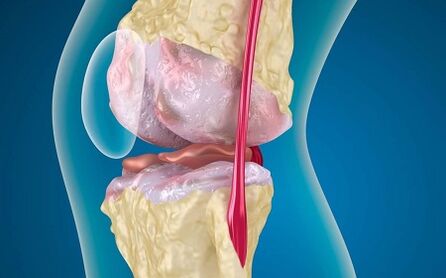
It will be such an unpleasant disease of the musculoskeletal system as osteoarthritis of the knee joint.From the article you can find out what kind of illness it is, why it occurs, what most important symptoms of the knee arthrosis are and how this insidious disease can be treated.
The osteoarthritis of the knee joint (a different name - gonar rose) is a chronic disease of the knee joint, in which the joint destruction of the articular cartilage, followed by a deformation of the joint and the limitation of motor activity, is mentioned in it.
Gonarthrosis is the most common type of osteoarthritis.Most of the time, the disease is diagnosed in people aged 40 and over.In the older age group, the osteoarthritis of the knee is more common in women, in younger patients the disease is diagnosed more often in men.In about 7% of cases, the disease leads to the development of disabilities.
Reasons
The main causes for the development of the disease are:
- Violation of the metabolism in the body;
- Obesity, which leads to an increase in the load on the knee mosquitoes;
- increased fragility of capillaries, various circulatory disorders;
- Injuries to the knee joints (cracks, fractures, meniscus fracture, ligaments);
- some endocrine diseases;
- Inflammatory joint diseases (arthritis, rheumatism);
- old injuries that have been healed incorrectly;
- Courses of traumatic sports for knees (heavy athletics, bodybuilding, football, gymnastics, tennis, athletics);
- hereditary disposition;
- Congenital anomalies of the structure of the knee joint.
Types of osteoarthritis
The following types of osteoarthritis differ from the origin:
- primary- Most of the time, older people occur, endangered patients with obesity;
- secondary- It develops according to the violations of the knee or the infectious diseases that have been healed incorrectly.
After the localization of the pathological process, the following types of knee arthrosis are differentiated:
- Left -- influences the left knee joint, most often observed in athletes and medium age patients with obesity;
- Right out- affects the right knee joint, can be found more often in athletes and people whose work is associated with increased dynamic and static stress on the right leg.
- bilateral- The hardest type of osteoarthritis of the knee joint, which can lead to disabilities, is most frequently found in older people.
Symptoms
The most important clinical signs of the disease are:
- The pain in the knee - first the pain occurs with increased physical exertion on the joint, movement, running, long walking and the pause when the disease develops.Patients arise when they try to move after a long period of rest, a person with knee arthrosis is difficult to go down the stairs, over time the pain becomes constant.
- Morning stiffness in the knee joint - takes about half an hour, over time the duration can increase.
- Crunch in the knee when moving;
- With the development of the inflammatory process, the patients complain about the feeling of severity in the knee, the joint is slightly swelled and increases.
- The form of the connection gradually changes, its deformation occurs;
- With the further development of the disease, lameness appears, movements in the knee joint are limited, the patient cannot completely impress the painful leg.
- The atrophy of the femoral muscles gradually develops, they become weak and limp, and the volume decreases.
Treatment
If the first unpleasant symptoms occur, you must immediately consult a doctor and undergo an examination.Timely treatment increases the risk of recovery and improves the prognosis.Self -medication is unacceptable and can lead to the development of a series of complications up to disability!
The treatment of knee osteoarthritis includes the following stages.
Not -drug therapy
- The painful joint has to stand to rest, so that crutches or sticks are used for unloading.
- Ultraviolet radiation, warmth - to remove pain;
- Special orthopedic shoes, knee bikes, special insoles;
- Massage, training therapy, physiotherapy - are prescribed after the acute stage of the disease has been stopped.
Pharmaceutical therapy

- Reception of the NSAIDs in inside (tablets) and external (gels, ointments) - to relieve inflammation and pain in the knee;
- In the absence of the effect of taking NSAIDs, injections from special drugs are carried out into the joint cavity.
- Slow system systems - metabolic processes in cartilage;
- Funds to improve blood circulation - contribute to the normalization of blood circulation in the pathological focus and to improve the delivery of medicinal products to the damage zone.
Surgical intervention
It is shown with a complete loss of the joint function and includes the prostheses of the knee joint.
Health for you and your loved ones!

























